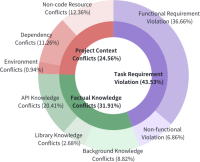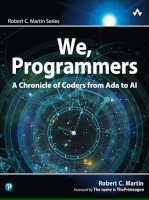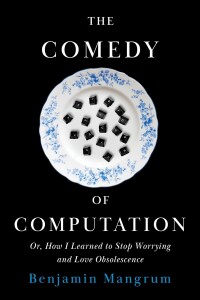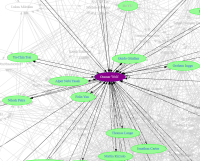 Last week, our university held a «Mega Vaccination Center». Things cannot be small or regular with my university, ever! According to the official information, during last week ≈31,000 people were given a total of ≈74,000 vaccine dosis against influenza, COVID-19, pneumococcal disease and measles (specific vaccines for each person selected according to an age profile). I was a tiny blip in said numbers. One person, three shots. Took me three hours, but am quite happy to have been among the huge crowd. (↑ photo credit: La Jornada, 2025.11.14) And why am I bringing this up? Because I have long been...
Last week, our university held a «Mega Vaccination Center». Things cannot be small or regular with my university, ever! According to the official information, during last week ≈31,000 people were given a total of ≈74,000 vaccine dosis against influenza, COVID-19, pneumococcal disease and measles (specific vaccines for each person selected according to an age profile). I was a tiny blip in said numbers. One person, three shots. Took me three hours, but am quite happy to have been among the huge crowd. (↑ photo credit: La Jornada, 2025.11.14) And why am I bringing this up? Because I have long been...Gunnar Wolf - Nice grey life
Showing posts 1 – 10
 Last week, our university held a «Mega Vaccination Center». Things cannot be small or regular with my university, ever! According to the official information, during last week ≈31,000 people were given a total of ≈74,000 vaccine dosis against influenza, COVID-19, pneumococcal disease and measles (specific vaccines for each person selected according to an age profile). I was a tiny blip in said numbers. One person, three shots. Took me three hours, but am quite happy to have been among the huge crowd. (↑ photo credit: La Jornada, 2025.11.14) And why am I bringing this up? Because I have long been...
Last week, our university held a «Mega Vaccination Center». Things cannot be small or regular with my university, ever! According to the official information, during last week ≈31,000 people were given a total of ≈74,000 vaccine dosis against influenza, COVID-19, pneumococcal disease and measles (specific vaccines for each person selected according to an age profile). I was a tiny blip in said numbers. One person, three shots. Took me three hours, but am quite happy to have been among the huge crowd. (↑ photo credit: La Jornada, 2025.11.14) And why am I bringing this up? Because I have long been... How good can large language models (LLMs) be at generating code? This may not seem like a very novel question, as several benchmarks (for example, HumanEval and MBPP, published in 2021) existed before LLMs burst into public view and started the current artificial intelligence (AI) “inflation.” However, as the paper’s authors point out, code generation is very seldom done as an isolated function, but instead must be deployed in a coherent fashion together with the rest of the project or repository it is meant to be integrated into. Today, several benchmarks (for example, CoderEval or EvoCodeBench) measure the functional correctness...
How good can large language models (LLMs) be at generating code? This may not seem like a very novel question, as several benchmarks (for example, HumanEval and MBPP, published in 2021) existed before LLMs burst into public view and started the current artificial intelligence (AI) “inflation.” However, as the paper’s authors point out, code generation is very seldom done as an isolated function, but instead must be deployed in a coherent fashion together with the rest of the project or repository it is meant to be integrated into. Today, several benchmarks (for example, CoderEval or EvoCodeBench) measure the functional correctness... One of my servers at work leads a very light life: it is our main backups server (so it has a I/O spike at night, with little CPU involvement) and has some minor services running (i.e. a couple of Tor relays and my personal email server — yes, I have the authorization for it 😉). It is a very stable machine… But today I was surprised: As I am about to migrate it to Debian 13 (Trixie), naturally, I am set to reboot it. But before doing so: $ w 12:21:54 up 1048 days, 0 min, 1 user, load average:...
One of my servers at work leads a very light life: it is our main backups server (so it has a I/O spike at night, with little CPU involvement) and has some minor services running (i.e. a couple of Tor relays and my personal email server — yes, I have the authorization for it 😉). It is a very stable machine… But today I was surprised: As I am about to migrate it to Debian 13 (Trixie), naturally, I am set to reboot it. But before doing so: $ w 12:21:54 up 1048 days, 0 min, 1 user, load average:... When this book was presented as available for review, I jumped on it. After all, who doesn’t love reading a nice bit of computing history, as told by a well-known author (affectionaly known as “Uncle Bob”), one who has been immersed in computing since forever? What’s not to like there? Reading on, the book does not disappoint. Much to the contrary, it digs into details absent in most computer history books that, being an operating systems and computer architecture geek, I absolutely enjoyed. But let me first address the book’s organization. The book is split into four parts. Part 1,...
When this book was presented as available for review, I jumped on it. After all, who doesn’t love reading a nice bit of computing history, as told by a well-known author (affectionaly known as “Uncle Bob”), one who has been immersed in computing since forever? What’s not to like there? Reading on, the book does not disappoint. Much to the contrary, it digs into details absent in most computer history books that, being an operating systems and computer architecture geek, I absolutely enjoyed. But let me first address the book’s organization. The book is split into four parts. Part 1,...Many people that were once enthusiast Twitter users have dropped as a direct or indirect effect of its ownership change and the following policy changes. Given Twitter X is getting each time more irrelevant, it is less interesting and enciting for more and more people… But also, its current core users (mostly, hate-apologists of the right-wing mindset that finds conspiration theories everywhere) are becoming more commonplace, and by sheer probability (if not for algorithmic bias), every time it becomes more likely a given piece of content will be linked to what their authors would classify as crap. So, there has...
 Just wanted to share… I enjoy reading George V. Neville’s Kode Vicious column, which regularly appears on some of ACM’s publications I follow, such as ACM Queue or Communications. Today I was very pleasantly surprised, while reading the column titled «Can’t we have nice things» Kode Vicious answers to a question on why computing has nothing comparable to the beauty of ancient physics laboratories turned into museums (i.e. Faraday’s laboratory) by giving a great hat tip to a project stemmed off Debian, and where many of my good Debian friends spend a lot of their energies: Reproducible builds. KV says:...
Just wanted to share… I enjoy reading George V. Neville’s Kode Vicious column, which regularly appears on some of ACM’s publications I follow, such as ACM Queue or Communications. Today I was very pleasantly surprised, while reading the column titled «Can’t we have nice things» Kode Vicious answers to a question on why computing has nothing comparable to the beauty of ancient physics laboratories turned into museums (i.e. Faraday’s laboratory) by giving a great hat tip to a project stemmed off Debian, and where many of my good Debian friends spend a lot of their energies: Reproducible builds. KV says:... “The Comedy of Computation” is not an easy book to review. It is a much enjoyable book that analyzes several examples of how “being computational” has been approached across literary genres in the last century — how authors of stories, novels, theatrical plays and movies, focusing on comedic genres, have understood the role of the computer in defining human relations, reactions and even self-image. Mangrum structures his work in six thematic chapters, where he presents different angles on human society: How have racial stereotypes advanced in human imagination and perception about a future where we interact with mechanical or computational...
“The Comedy of Computation” is not an easy book to review. It is a much enjoyable book that analyzes several examples of how “being computational” has been approached across literary genres in the last century — how authors of stories, novels, theatrical plays and movies, focusing on comedic genres, have understood the role of the computer in defining human relations, reactions and even self-image. Mangrum structures his work in six thematic chapters, where he presents different angles on human society: How have racial stereotypes advanced in human imagination and perception about a future where we interact with mechanical or computational... So, for the first year, this year’s DebConf had the “DebConf Academic Track”, that is, content for a one-day-long set of short sessions, for which of them there was a written article presenting the content — often with a very academic format, but not necessarily. I hope that for future DebConfs we will continue to hold this track, and that we can help bridge the gap: to get people that are not usually from the academic / universitary prepare content that will be formally expressed and included in a long-lasting, indexed book of proceedings. We did have (informal) proceedings in...
So, for the first year, this year’s DebConf had the “DebConf Academic Track”, that is, content for a one-day-long set of short sessions, for which of them there was a written article presenting the content — often with a very academic format, but not necessarily. I hope that for future DebConfs we will continue to hold this track, and that we can help bridge the gap: to get people that are not usually from the academic / universitary prepare content that will be formally expressed and included in a long-lasting, indexed book of proceedings. We did have (informal) proceedings in... As I often do, this year I have also prepared a set of personalized maps for your OpenPGP keysigning in DebConf25, in Brest! What is that, dare you ask? One of the not-to-be-missed traditions of DebConf is a Key-Signing Party (KSP) that spans the whole conference! Travelling from all the corners of the world to a single, large group gathering, we have the ideal opportunity to spread some communicable diseases trust on your peers’ identities and strengthen Debian’s OpenPGP keyring. But whom should you approach for keysigning? Go find yourself in the nice listing I have prepared. By clicking on...
As I often do, this year I have also prepared a set of personalized maps for your OpenPGP keysigning in DebConf25, in Brest! What is that, dare you ask? One of the not-to-be-missed traditions of DebConf is a Key-Signing Party (KSP) that spans the whole conference! Travelling from all the corners of the world to a single, large group gathering, we have the ideal opportunity to spread some communicable diseases trust on your peers’ identities and strengthen Debian’s OpenPGP keyring. But whom should you approach for keysigning? Go find yourself in the nice listing I have prepared. By clicking on...subscribe via RSS
 Found this grafitti on the wall behind my house today:
Found this grafitti on the wall behind my house today: